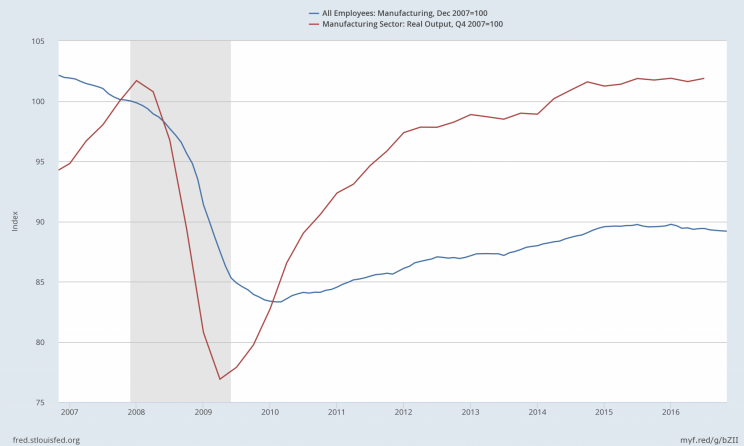The jobs report is a perfect example of fake news
On Friday, we learned the US economy added 178,000 jobs in November and the unemployment rate fell to 4.6%, while over 95 million Americans were not in the labor force.
Each of these numbers — which come from a 39-page report filled with numbers — is true. But each of these numbers can be framed in various ways to tell wildly different stories.
One person can say the unemployment rate is 4.6%. Another person can look at the same report and say the unemployment rate is 40.3%.
40.3% unemployment rate ?!?!
Some folks might argue the “real” unemployment rate is 40.3%. But they are being a bit disingenuous with their calculation.
The 40.3% would be calculated by subtracting the employment-to-population ratio — which stands at 59.7% — from 100% of the US population over 16 (which the BLS terms the “civilian noninstitutional population”). This pool, however, includes 95 million people who are not actively looking for jobs and are classified by the BLS as not in the labor force. Many of these are retirees, the sick, stay-at-home parents, or full-time students, among other folks who may have reasons for not seeking work.
The 4.6% figure, considered the official unemployment rate, only considers those who either have jobs or are looking for jobs. In other words, 4.6% of the active US labor force does not currently have a job.
Critics argue that the 4.6% rate does not consider those who may want a job but have given up looking for work. There are, however, alternative unemployment rates that consider those who are discouraged or marginally attached to the workforce. (The “U-4” rate, which is unemployed plus discouraged workers, was 5% in November; the “U-6” rate, which is unemployed plus those employed part-time for economic reasons and those marginally attached to the workforce, was 9.3% in November.)
And the thing is, we could go on like this forever.
An informed interpreter of this report knows, however, the 40.3% figure can simply not be advanced as the “real unemployment rate” in good faith.
This figure exists in the report as the accurately calculated difference of two numbers. But it is not the “real unemployment rate.” It is just bad math.

Fake news
In a political and media environment that has seen an obsession with fake news define the zeitgeist, the jobs report is worth considering as the beginning and end of this phenomenon.
The jobs report is tabulated each month by civil servants and spun as both gospel and heresy no matter the results.
Each month, markets sharpen their narrative knives for this monthly report, seeking to confirm or deny their pre-existing belief that the US economy is in good or bad shape. And every month, the jobs report delivers.
But the report’s fake news characteristics are not because it is published by teens in Macedonia, but because it is full of different “truths” that can be seized on to advance your agenda.
Consider that in 2015, President-elect Donald Trump called the official unemployment rate (the current 4.6%, which then stood at 5.1%) “phony” while touting other figures that ran as high as 42%.
And consider the above calculation of 40.3% as the “real” unemployment rate. If you wanted to affirm a view that the US economy is doing terribly, this would be a number to seize on. It would be a number that, again, you can find in the government’s own jobs report. It just would not say what you think.
Fake news is not always about outright falsehoods; it is also about facts telling a supposedly true story that just isn’t so.

The good and the bad
If you’re looking on the bright side, the unemployment rate in November fell to its lowest level since August 2007 (4.6%), while the underemployment rate — which includes both those out of work and those who want work but can’t find any — is at its lowest since April 2008 (9.3%).
Less encouragingly, 5.88 million Americans currently want a job and the labor force participation rate — at 62.7% — remains near a multi-decade low. Manufacturing employment also fell by 4,000 in November and jobs in this sector have declined by 78,000 since January.
But the other rub is that the numbers reported Friday will be revised in each of the next two monthly reports. October’s report, for example, now indicates 142,000 jobs were added to the economy, fewer than the 161,000 initially reported. But Friday’s report showed September’s job gains were revised higher to 208,000 from 191,000.
Then there are annual revisions.
But the goal of a monthly jobs report — as with any economic survey — is to provide a snapshot of where the economy appears to stand based on a consistent set of data points collected in a uniform manner.
And it is because the jobs report is gathered the same way each month, and seasonally adjusted in a clear, detailed fashion, that markets are able to react to the report and make broad observations about where things stand.
It is the breadth and depth of the report, however, that also allows it to be spun almost any way one chooses.
Manufacturing spin
In a statement on Friday, RNC co-chair Sharon Day said, “The 4,000 manufacturing jobs that disappeared last month come on top of the over 300,000 that have been lost under President Obama, more proof that President-elect Donald Trump’s efforts to stand up for the American worker is the commitment our country needs right now.”
All true.
The balance of Day’s statement discussed Trump’s recent back-and-forth with Carrier that kept some — but not all — of the jobs scheduled to move from Indiana to Mexico in the US.

And while you expect the RNC to emphasize points from one of Trump’s most resonant campaign messages, Friday’s jobs report also reinforces that Trump will inherit an economy doing about as well as we’ve seen in a decade.
In the third quarter, the economy grew at a 3.2% clip, and, again, the unemployment rate stands at nearly a decade low. Wages are rising faster than inflation. The stock market is at record highs. Consumer confidence is at its highest point since before the financial crisis.
Additionally, much has been written about how manufacturing jobs are never coming back to the US. It isn’t about outsourcing but about the automation of the workforce. Employment in manufacturing is down but output is up. Efficiency, not China, is killing US manufacturing jobs.

But none of that changes the fact — yes, undisputed fact — that the economy has lost 300,000 manufacturing jobs during Obama’s time in office.
It is this “my facts vs. your facts” dynamic that really creates fake news.
—
Myles Udland is a writer at Yahoo Finance. Follow him on Twitter @MylesUdland
Read more from Myles here:

